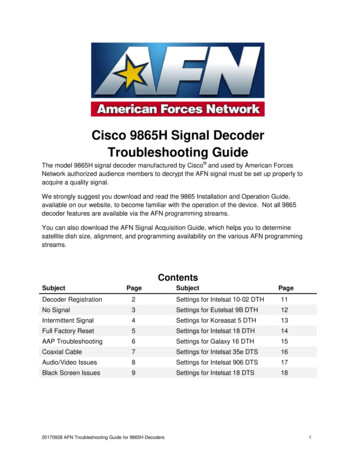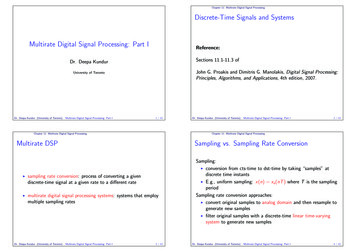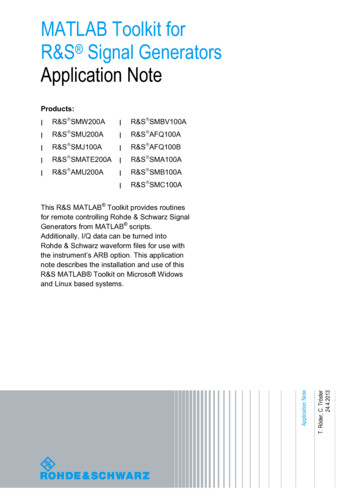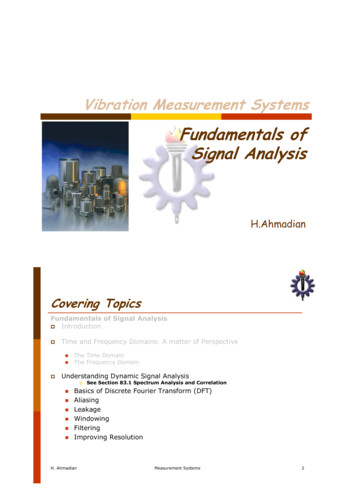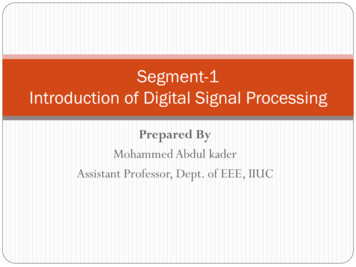
Transcription
Army Regulation 530–1Operations and Signal SecurityOperationsSecurityHeadquartersDepartment of the ArmyWashington, DC26 September 2014UNCLASSIFIED
SUMMARY of CHANGEAR 530–1Operations SecurityThis major revision, dated 26 September 2014-oUpdates operations security terms and definitions with Department of Defenseand Joint usage (para 1-5).oAdds Administrative Assistant to the Secretary of the Army responsibility forthe HQDA operations security program (para 2-2).oAdds guidance to authorize purchases of operations security awareness andtraining products (para 3-3).oAdds Operations Security Level III training certification requirements (para4-2c).oAdds operations security and external official presence trainingrequirements (para 4-3).oUpdates Joint and interagency training guidelines (para 4-4).oUpdates operations security assessment procedures (para 5-4).oUpdates operations security contractual documents review requirements (chap6).oAdds cyberspace critical information sample (app C-27).oUpdates guidance for Army Operations Security Annual Report Program (app I).oUpdates guidance for Annual Army Operations Security Achievement AwardsProgram (app J).oUpdates Army command, Army service component command, and direct reportingunit listing (app K).oUpdates Freedom of Information Act (Title 5, United States Code, Section 552)Exemption 2 guidance (app L).oAdds operations security internal control evaluation (app O).oMakes administrative changes (throughout).
*Army Regulation 530–1HeadquartersDepartment of the ArmyWashington, DC26 September 2014Effective 26 October 2014Operations and Signal SecurityOperations Securityby Information Operations as prescribedin Joint Publication 3–13.History. This publication is a majorrevision.Summary. This regulation fully implements National Security Decision Directive 298, Chairman, Joint Chiefs of StaffInstruction 3213.01D, Joint Publication3–13.3, and Department of Defense directive 5205.02E and Department of Defense5205.02–M. This regulation states Armypolicy on operations security program development, revises terminology, providesdetails on the operations security planningprocess, and outlines the operations security review, assessment and survey requirements. The Army operations securityprogram authority is consistent with Jointpolicy and doctrine in Chairman, JointChiefs of Staff Instruction 3213.01D andJoint Publication 3–13.3. In Joint andArmy operations, operations security is aninformation-related capability integratedContentsApplicability. This regulation applies tomilitary and civilian personnel of the Active Army, the Army National Guard, theU.S. Army Reserve, and related activitiesof those organizations. Contractors mustcomply with contractually imposed operations security requirements. Also, if contractors have access to governmentinformation they are required to followthe same requirements for protection ofsensitive, unclassified government information per Joint Ethics Regulation andPublic Law. This regulation applies fromconception of an activity or project andduring all phases of operations, includingtraining, readiness, and mobilization.Proponent and exception authority.The proponent of this regulation is theDeputy Chief of Staff, G–3/5/7. The proponent has the authority to approve exceptions or waivers to this regulation thatare consistent with controlling law andregulations. The proponent may delegatethis approval authority, in writing, to adivision chief with the proponent agencyor its direct reporting unit or field operating agency, in the grade of colonel or thecivilian equivalent. Activities may requesta waiver to this regulation by providingjustification that includes a full analysis ofthe expected benefits and must includeformal review by the activity’s seniorlegal officer. All waiver requests will beendorsed by the commander or seniorleader of the requesting activity and forwarded through higher headquarters to thepolicy proponent. Refer to AR 25–30 formore information.Army internal control process. Thisregulation contains internal control provisions in accordance with AR 11–2 andidentifies key internal controls that mustbe evaluated (see app O).Supplementation. Supplementation ofthis regulation and establishment of command and local forms are prohibited without prior approval from Deputy Chief ofStaff, G–3/5/7 (G–39), 400 Army Pentagon, Washington, DC 20310.Suggested improvements. Users areinvited to send comments and suggestedimprovements on DA Form 2028 (Recommended Changes to Publications andBlank Forms) directly to the e-mail address at il.Distribution. This regulation is availablein electronic media only and is intendedfor command levels B, C, D and E for theActive Army, the Army National Guard,and U.S. Army Reserve.(Listed by paragraph and page number)Chapter 1Introduction, page 1Purpose 1–1, page 1References 1–2, page 1Explanation of abbreviations and special terms 1–3, page 1Responsibilities 1–4, page 1Definitions 1–5, page 1*This regulation supersedes AR 530–1, dated 17 April 2007.AR 530–1 26 September 2014UNCLASSIFIEDi
Contents—ContinuedRequirement 1–6, page 2Application 1–7, page 2Proponent 1–8, page 3Chapter 2Responsibilities, page 3Assistant Secretary of the Army (Acquisition, Logistics, and Technology) 2–1, page 3Administrative Assistant to the Secretary of the Army 2–2, page 3Chief Information Officer/G–6 2–3, page 3The Inspector General 2–4, page 4Office of the Chief of Public Affairs (OCPA) 2–5, page 4Deputy Chief of Staff, G–2 2–6, page 4Deputy Chief of Staff, G–3/5/7 2–7, page 4Commanders of Army commands, Army service component commands, and direct reporting units 2–8, page 4Commander, Training and Doctrine Command (TRADOC) 2–9, page 5Commander, U.S. Army Materiel Command (AMC) 2–10, page 5Commander, U.S. Army Intelligence and Security Command (INSCOM) 2–11, page 5Commander, U.S. Army Criminal Investigation Command 2–12, page 6Commanding General, Installation Management Command 2–13, page 6Commander, Army Test and Evaluation Command and commanders, subordinate commanders, and directors of majortest ranges, centers, and facilities 2–14, page 6Commander, 1st Information Operations Command (Land) 2–15, page 6Army operations security support element 2–16, page 6Army Web risk assessment cell 2–17, page 7Commanders and directors of units, activities, and installations at battalion and higher echelons 2–18, page 7Commanders at all levels, agency directors 2–19, page 9Garrison commanders 2–20, page 9Program executive officers and program, project, or product managers 2–21, page 9All Army personnel 2–22, page 10Chapter 3Policy and Procedures, page 11General 3–1, page 11Operations security programs 3–2, page 11Program awareness and training product promotion 3–3, page 12Threat analysis support to OPSEC 3–4, page 12Chapter 4Training Requirements, page 13Overview 4–1, page 13Training programs 4–2, page 13OPSEC and external official presence training 4–3, page 15Joint and interagency training 4–4, page 15Chapter 5Operations Security Review, Assessment, and Survey, page 16Section IOperations Security Review, page 16General 5–1, page 16Procedures 5–2, page 16Section IIOperations Security Assessment, page 16General 5–3, page 16iiAR 530–1 26 September 2014
Contents—ContinuedProcedures 5–4, page 17Section IIIOperations Security Survey, page 17General 5–5, page 17Procedures 5–6, page 17Chapter 6Operations Security Contractual Documents Review Requirements, page 18Overview 6–1, page 18Policy and procedures 6–2, page 18Chapter 7Special Access Programs, page 19Overview 7–1, page 19Policy 7–2, page 19AppendixesA.References, page 20B.The Operations Security Process, page 22C.Sample Critical Information, page 26D.Operations Security Indicators, page 29E.The Threat, page 32F.Sample Operations Security Measures, page 35G.Operations and Security Relationships to Security Programs, page 36H.Standard Duty Description for Operations Security Program Managers, Officers, and Coordinators, page 38I.Annual Operations Security Report Format, page 40J.Annual Army Operations Security Achievement Awards Program, page 41K.Army Commands, Army Service Component Commands, and Direct Reporting Units, page 43L.Information That May Be Exempt from Release under the Freedom of Information Act, page 44M.Format for Operations Security Annex/Appendix/Tab to Operation Plan/Operation Order, page 45N.Format for Operations Security Documents, page 47O. Internal Control Evaluation, page 54Figure N–3:N–3:Sample format for OPSEC annex/appendix/tab to OPORD/OPLAN, page 46Sample format for OPSEC annex/appendix/tab to OPORD/OPLAN–continued, page 47OPSEC plan, page 48OPSEC plan—continued, page 49Appendix 1 to OPSEC plan, page 50Appendix 1 to OPSEC plan—continued, page 51Appendix 1 to OPSEC plan—continued, page 52Appendix 2 to OPSEC plan, page 53Appendix 2 to OPSEC plan—continued, page 54GlossaryAR 530–1 26 September 2014iii
Chapter 1Introduction1–1. PurposeThis regulation prescribes policy and procedures for operations security (OPSEC) in the Army.1–2. ReferencesRequired and related publications and prescribed and referenced forms are listed in appendix A.1–3. Explanation of abbreviations and special termsAbbreviations and special terms used in this regulation are explained in the glossary.1–4. ResponsibilitiesResponsibilities are listed in chapter 2. Responsibilities referring to commanders and similar terms are equallyapplicable to equivalent management and supervision positions in organizations that do not employ a traditionalmilitary command structure.1–5. Definitionsa. Operations security.(1) As defined in Department of Defense Directive (DoDD) 5205.02E, OPSEC is a process of identifying criticalinformation and analyzing friendly actions attendant to military operations and other activities to—(a) Identify those actions that can be observed by adversary intelligence systems.(b) Determine indicators and vulnerabilities that adversary intelligence systems might obtain to be able to interpretor piece together to derive critical information in time to use against U.S. and/or friendly missions and poses anunacceptable risk.(c) Select and execute measures that eliminate the risk to friendly actions and operations or reduce to an acceptablelevel.(2) OPSEC protects sensitive and/or critical information from adversary observation and collection in ways thattraditional security programs cannot. While these programs, such as Information Assurance (IA), protect classifiedinformation, they cannot prevent all indicators of critical information, especially unclassified indicators, from beingrevealed.(3) In concise terms, the OPSEC process identifies the critical information of military plans, operations, andsupporting activities and the indicators that can reveal it, and then develops measures to eliminate, reduce, or concealthose indicators. It also determines when that information may cease to be critical in the lifespan of an organization’sspecific operation.b. Critical information.(1) Critical information, formerly known as essential elements of friendly information, is defined as informationimportant to the successful achievement of U.S. objectives and missions, or which may be of use to an adversary of theUnited States.(2) Critical information consists of specific facts about friendly capabilities, activities, limitations (includes vulnerabilities), and intentions needed by adversaries for them to plan and act effectively so as to degrade friendly missionaccomplishment.(3) Critical information is information that is vital to a mission that if an adversary obtains it, correctly analyzes it,and acts upon it; the compromise of this information could prevent or seriously degrade mission success.(4) Critical information can either be classified or unclassified depending upon the organization, activity, or mission.Critical information that is classified requires OPSEC measures for additional protection because it can be revealed byunclassified indicators. Critical information that is unclassified especially requires OPSEC measures because it is notprotected by the requirements pertaining to classified information. Critical information can also be an action thatprovides an indicator of value to an adversary and places a friendly activity or operation at risk.c. Sensitive information and controlled unclassified information (CUI). See DoD Manual 5200.01, Volume 4.d. OPSEC compromise.(1) An OPSEC compromise is the disclosure of sensitive and/or critical information that jeopardizes a unit’s abilityto execute its mission or to adequately protect its personnel and/or equipment or effects national security.(2) For sensitive and/or critical information that has been compromised and is available in open sources, the publicdomain should not be highlighted or referenced publicly outside of intra-governmental or authorized official communications, because these actions provide further unnecessary exposure of the compromised information. Personnel shouldnot respond to queries to deny or confirm the validity of sensitive information that has been compromised or releasedto the public. Notify your organization’s OPSEC officer and security manager of all OPSEC compromises.AR 530–1 26 September 20141
1–6. Requirementa. The National OPSEC Program outlined in National Security Decision Directive 298 (NSDD 298) requires eachexecutive department and agency with a national security mission to have an OPSEC program. Likewise, DoDD 5205.02E supports the national program and requires each DoD component to have an OPSEC program.b. OPSEC maintains essential secrecy, which is the condition achieved by the denial of critical information toadversaries. Adversaries in possession of critical information can hinder or prevent friendly mission accomplishment.Thus, essential secrecy is a necessary prerequisite for effective operations. Essential secrecy depends on the combination and full implementation of two approaches to protection—(1) OPSEC to deny adversaries critical information and indicators of sensitive information.(2) Traditional security programs to deny adversaries classified, sensitive, and/or critical information include—(a) Information security.(b) Information assurance.(c) Electronic security.(d) Emission security.(e) Military deception.(f) Physical security.(g) Program protection planning.(h) Personnel security.(i) Industrial security.c. OPSEC provides a methodology to manage risk. It is impossible to avoid all risk and protect everything. Toattempt complete protection diverts resources from actions needed for mission success.1–7. Applicationa. OPSEC awareness and execution is crucial to Army success. OPSEC is applicable to all personnel, missions, andsupporting activities on a daily basis. OPSEC denies adversaries information about friendly capabilities, activities,limitations, and intentions that adversaries need to make competent operational decisions. Without prior knowledge offriendly actions, adversary leaders cannot act effectively to prevent friendly mission accomplishment. It applies to allArmy activities and is required during training, sustaining, mobilizing, preparing for, and conducting operations,exercises, tests, or activities.(1) OPSEC contributes directly to the Army’s ability to employ forces to gain superiority over an adversary acrossthe full spectrum of operations. Without sensitive and/or critical information about our forces, adversaries cannotdesign and build systems, devise tactics, train, or otherwise prepare their forces (physically or psychologically) in timeto effectively counter the Army’s capabilities, activities, and intentions, and exploit the Army’s limitations.(2) Combat capability increasingly depends upon gaining and maintaining information superiority. This impacts allaspects of raising, equipping, training, deploying, employing, and sustaining forces. Every Army organization producesor has information that ultimately affects the ability of U.S. forces to accomplish missions. Every organization mustidentify and protect this information (for example, emerging tactics, techniques and procedures) which an adversarycould use against U.S. forces.(3) Research, development, test and evaluation (RDT&E) activities are particularly vulnerable to sensitive information and technology disclosure, both classified and unclassified, due to the long life of the development process and thelarge number of personnel, organizations, and contracted companies involved. Sensitive and/or critical information lostduring the development process can result in an adversary countermeasures being developed even before a system isfielded. Systems protection, to include the acquisition process, is necessary to preserve the advantage of technologicalsuperiority of U.S. forces. OPSEC assessments and surveys will be used to evaluate the vulnerabilities of sensitiveinformation and technology during the RDT&E phases.(4) Army program executive officers (PEOs), program, project, or product managers, and contracting officials mustconsider OPSEC as a stipulation in all contracts. All requirements packages must receive two OPSEC reviews by therequiring activity (RA) OPSEC officer.(a) At the beginning of the contracting process to determine if OPSEC requirements are needed in the performancework statement (PWS).(b) At the end of the contracting process for sensitive and/or critical information prior to public release. Foradditional guidance, see paragraph 2–7 and chapter 6 of this regulation.(5) The U.S. Government is a party to various arms control agreements, which allow access by foreign officials toU.S. military installations and supporting contractor facilities. Prior coordination with the foreign disclosure officermust be conducted before sharing government information with any foreign official.(a) Intermediate-range nuclear forces, the Chemical Weapons Convention and the new Strategic Arms ReductionTreaty agreements have provisions for on-site inspections. Under the Chemical Weapons Convention, challengeinspections may occur at sites and in buildings that have nothing to do with declared chemical weapons activity.Regional multi-national treaties, such as the Conventional Armed Forces in Europe Treaty or the Vienna Document2AR 530–1 26 September 2014
2011, affect Army units stationed on host country territory. Army units can be subject to observations of unit activityin garrison or while deployed on the territory of a country which is also a treaty participant. With only 72 hours ofadvance notice, the Open Skies Treaty allows reconnaissance over flights anytime, anywhere, with few exceptions.(b) These agreements, while enhancing U.S. national security, provide adversaries with opportunities to collectsensitive and/or critical information unrelated to the treaties. Each Army organization or activity must have an OPSECplan/standing operating procedure (SOP) to protect sensitive and/or critical information unrelated to legitimate inspection aims. The plan/SOP must direct immediate implementation of OPSEC measures for daily vulnerabilities. This mayhelp to avoid compromise of sensitive and/or critical information and activities that are likely collateral collectiontargets of these foreign inspections unrelated to the treaties. The plan/SOP must also have additional measures that arespecific for a particular inspection regime. These additional OPSEC measures must be ready for implementationimmediately after notice of an impending inspection.b. OPSEC is more important now than it has ever been. The United States faces cunning and ruthless adversariesusing asymmetric techniques to avoid our strengths. The first step for them to inflict harm is to gather informationabout us. They are exploiting the openness and freedoms of our society by aggressively reading and collecting materialthat is needlessly exposed to them. Good OPSEC practices can prevent these compromises and allow us to maintainessential secrecy about our operations.1–8. ProponentThe Deputy Chief of Staff (DCS), G–3/5/7 is the Army’s proponent for OPSEC. At lower echelons, the command,unit, activity, or installation operations officer is the staff proponent for OPSEC. OPSEC is an operations function thatdenies critical information and requires close integration with other security programs. While OPSEC is not anintelligence function, it relies heavily upon intelligence processes in threat determination and program effectivenessevaluation.Chapter 2Responsibilities2–1. Assistant Secretary of the Army (Acquisition, Logistics, and Technology)In addition to the requirements outlined in paragraphs 2–18, 2–19 and 2–22, the Assistant Secretary of the Army(Acquisition, Logistics, and Technology) will—a. Ensure program protection plans (PPPs) include OPSEC to protect critical information throughout the life cycleof Army acquisition systems.b. Ensure all individuals who perform acquisition duties receive OPSEC training (see chap 4 of this regulation) insupport of program protection planning.2–2. Administrative Assistant to the Secretary of the ArmyIn addition to the requirements outlined in paragraphs 2–8, 2–18, 2–19 and 2–22, the Administrative Assistant to theSecretary of the Army will—a. Appoint a HQDA Staff OPSEC PM with the responsibility for the OPSEC program for HQDA Staff andSecretariat.b. The HQDA Staff OPSEC PM will have the following responsibilities:(1) OPSEC tasking authority.(2) Provide guidance for OPSEC reviews for official information released to the public.(3) Conduct assessments for HQDA principal organizations.(4) The HQDA Staff OPSEC PM will be a separate position from the Army OPSEC PM in DCS, G–3/5/7 (G–39).2–3. Chief Information Officer/G–6In addition to the requirements outlined in paragraph 2–18, 2–19 and 2–22, the Army Chief Information Officer/G–6will—a. Ensure the development and integration of Army command, control, communications, and computer systemsinclude OPSEC to protect sensitive and/or critical information.b. Plan and implement OPSEC measures throughout the life cycle management of legacy and enterprise systems.c. Prescribe electromagnetic spectrum and frequency management guidance pertaining to Army OPSEC programs.d. Prescribe guidance pertaining to evolving voice, data, wireless, and other technologies as they apply to ArmyOPSEC programs per AR 380–53 and National Telecommunications and Information Systems Security Directive(NTISSD) No. 600.AR 530–1 26 September 20143
2–4. The Inspector GeneralIn addition to the requirements outlined in paragraph 2–18, 2–19 and 2–22, the Inspector General will—a. Ensure OPSEC is an item of interest in all inspections of organizations throughout the Army.b. Coordinate annually with the Army OPSEC PM on applicable OPSEC-related matters to ensure consistency withthis AR.2–5. Office of the Chief of Public Affairs (OCPA)In addition to the requirements outlined in paragraph 2–18, 2–19 and 2–22, OCPA will—a. Provide guidance on the public release of all official information to ensure the protection of sensitive and/orcritical information.b. Requires OPSEC be considered before any public release of DoD information, to include information to bepublished or released by DoD-affiliated persons in their private capacity. See AR 360–1 for additional information.c. Provide assistance to the Army OPSEC PM in increasing OPSEC awareness throughout the Army.2–6. Deputy Chief of Staff, G–2In addition to the requirements outlined in paragraph 2–18, 2–19 and 2–22, the DCS, G–2 will—a. Assist other Army staff organizations, agencies, and TRADOC in the development of training and doctrineprograms pertinent to all intelligence and CI aspects of OPSEC.b. Render foreign disclosure decisions regarding controlled unclassified information in accordance with AR 380–10.c. Serve as the proponent for program management of intelligence and CI support to OPSEC programs.d. Incorporate OPSEC policy into AR 380–49.e. Support integration of OPSEC as a measure in PPPs through the Army Research and Technology ProtectionCenter.2–7. Deputy Chief of Staff, G–3/5/7In addition to the requirements outlined in paragraph 2–18, 2–19 and 2–22, the DCS, G–3/5/7 will designate a full-timeArmy OPSEC PM with the grade of O–5 or above, or DA civilian equivalent. The Army OPSEC PM will—a. Develop Army OPSEC objectives, policies, and procedures in AR 530–1 consistent with applicable DoDDs andJoint publications.b. Provide guidance and oversight to ACOM, ASCC, and DRU OPSEC PMs ensuring OPSEC compliance ismaintained in accordance with established and regulatory guidance.c. Review and evaluate, annually, the Army’s OPSEC posture and the effectiveness of ACOM, ASCC, and DRUOPSEC programs; provide guidance and assistance as required.d. Identify resource requirements for the Army OPSEC Program.e. Coordinate, supervise, and execute DA OPSEC working groups with ACOM, ASCC, and DRU OPSEC PMs, andthe OSE.f. Coordinate with the Army OSE for training, policy development, and execution of the Army OPSEC Program.g. Coordinate for funding of elements providing OPSEC training support to the Army OPSEC Program.h. Facilitate coordination with TRADOC and OSE for the development of OPSEC doctrine and the integration ofOPSEC instruction at Army schools and training centers.i. Coordinate the Army program and maintain routine contact with the Joint Staff, other Services, and DOD.j. Submit the Army’s Annual OPSEC Report to the Office of the Under Secretary of Defense, Intelligence(OUSD(I)), as directed.k. Represent DA on interagency committees.l. Integrate intelligence and counterintelligence support into OPSEC planning and implementation, with the assistance of DCS, G–2 and other intelligence agencies.2–8. Commanders of Army commands, Army service component commands, and direct reportingunitsNote. See appendix K of this regulation or AR 10–87 for a complete listing of Army commands (ACOMs), Armyservice component commands (ASCCs), and direct reporting units (DRUs). Also, this regulation applies to executivedirectors as well as military commanders. For HQDA, the Administrative Assistant to the Secretary of the Armyexercises the same authorities as commanders of ACOMs and ASCCs, as prescribed by regulation, policy, delegation,or other issuance. In addition to the requirements outlined in paragraphs 2–18, 2–19 and 2–22, commanders will—a. Appoint a command OPSEC PM in writing.(1) Because of the significance of OPSEC at this level of command and authority, the commander will ensure thecommand’s OPSEC PM is a full-time duty position. The command OPSEC PM is responsible for numerous OPSECprograms within the command and provides guidance and oversight and coordinates their actions under the command’sOPSEC program. Dependent on the workload, an OPSEC officer or coordinator may be necessary to assist the4AR 530–1 26 September 2014
command’s OPSEC PM. Requests for waivers, with established justification, shall be signed by the commander andsubmitted to the Army OPSEC PM at DCS, G–3/5/7 (G–39).(2) The individual will be an experienced commissioned officer (at least an O–4 or W–3) or civilian equivalent. Thecommander can approve an exception to these rank/grade levels, in writing.(3) Because contractors do not have authority over U.S. military and government personnel and cannot represent theposition of the U.S. Government, contract employees will not be assigned as the command’s OPSEC PM or OPSECofficer. However, they may perform OPSEC duties in a supporting capacity as an OPSEC coordinator so long as theydo so under the supervision of a U.S. government employee or servicemember.b. Develop and implement functioning, active, and documented (formal) OPSEC programs for staff organizationswithin the command to meet their specific needs and to support the command’s OPSEC program.(1) With the assistance of the command’s OPSEC PM, commanders will decide which staff organizations withintheir command will develop and implement a formal OPSEC program.(2) The guiding principle to determine whether a staff organization will have a formal OPSEC program is based onthe sensitivity, visibility, and uniqueness of its mission.(3) Commanders may decide to incorporate a subordinate staff organization under a higher echelon staff organization’s OPSEC program. Commanders shall mandate that a subordinate staff organization determine their criticalinformation and develop OPSEC measures to protect their critical information.(4) Regardless of the level of implementation of OPSEC programs, every staff organization must have its ownOPSEC program or be covered under a higher echelon staff organization’s OPSEC program.c. Ensure ACOM, ASCC, and DRU OPSEC PMs maintain routine contact with the Army OPSEC PM. ACOM,ASCC, and DRU OPSEC PMs will provide updates, status reports, OPSEC issues, OPSEC compromises, lessonslearned, initiatives, requests for support, recommendations, personnel turnover, verification of contact information,media contacts, and so forth.d. Submit the command’s annual OPSEC report for the fiscal year to the Army OPSEC PM. Sample guidance and alist of representative data elements are provided in appendix I of this regulation.e. Ensure command OPSEC programs are examined as part of the Organizational Inspection Program outlined inAR 1–201.f. Ensure OPSEC annual training guidance is provided to subordinate elements.g. Identify OPSEC resource requirements through their command’s program objective memorandum process.h. Identify and resource additional OPSEC personnel requirements as required.i. Participate in HQDA-level OPSEC working groups and conferences.2–9. Commander, Training and Doctrine Command (TRADOC)In addition to the requirements out
J. Annual Army Operations Security Achievement Awards Program, page 41 K. Army Commands, Army Service Component Commands, and Direct Reporting Units, page 43 L. Information That May Be Exempt from Release under the Freedom of Information Act, page 44 M. Format for Operations Security Annex/Appendix/Tab to Operation Plan/Operation Order, page 45



